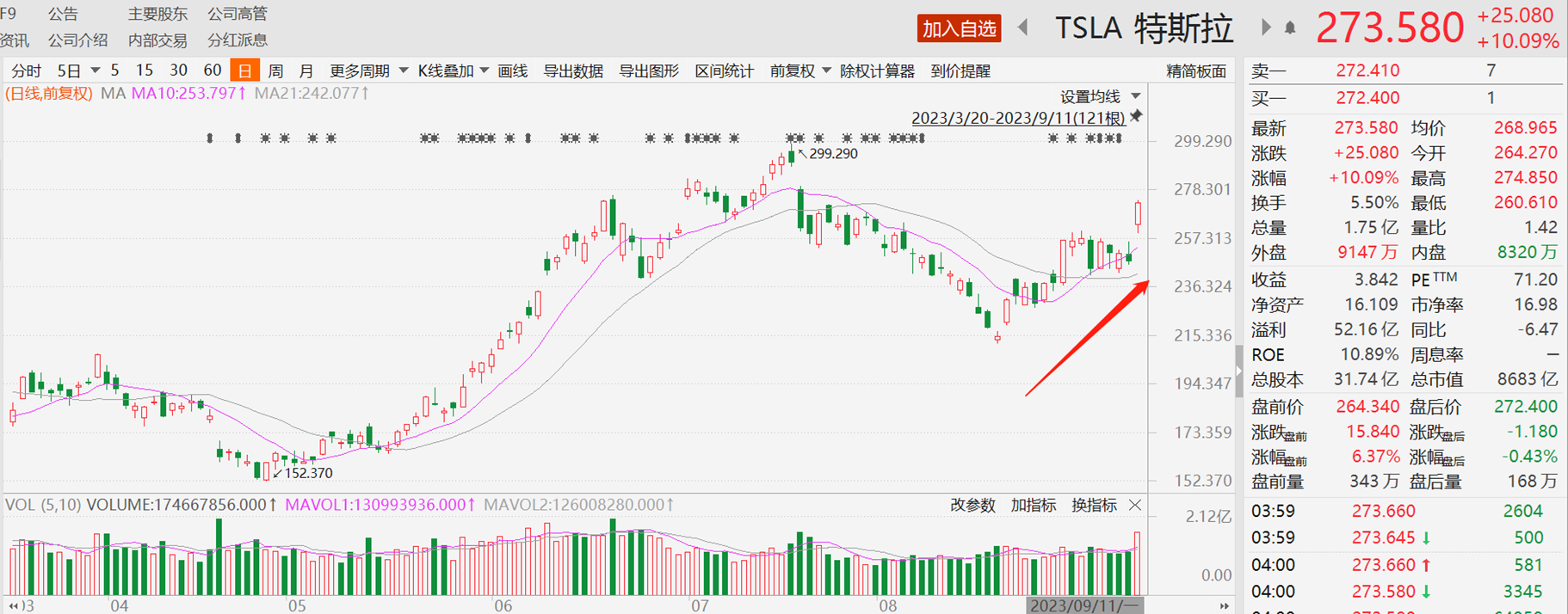Source: Caixin
Author: Zheng Yuanfang
On September 11th local time, Tesla's US stock surged more than 10%, expanding its year-to-date gain to 122%, with a single-day market value increase of $79.6 billion, reaching $868.341 billion.

The catalyst for the surge came from a report by Morgan Stanley - the report pointed out that Dojo, a supercomputer, will bring Tesla a market value increase of up to $500 billion, and raised Tesla's target price to $400. As a reference, after the surge on Monday, Tesla's stock closed at $273.58, still 46% below Morgan Stanley's expectations.
Analysts Adam Jonas and Daniela M Haigian's team pointed out in the report that the autonomous driving system is called the "mother of AI projects," and in the process of seeking solutions to autonomous driving, Tesla has developed the Dojo supercomputer, which can open up "new potential markets" for Tesla.
▌What is Dojo?
Dojo is a self-developed supercomputer by Tesla, which can use massive video data to complete "unsupervised" data annotation and training.
Literally, Dojo means "training ground, dojo," which also corresponds to its meaning - a practice ground for AI created by Tesla.
At Tesla's AI Day in 2021, Tesla had already released the Dojo supercomputer, but at that time it was still in its early stages, with only the first chip and training block, and the company was still pushing to build a complete Dojo Exapod.
Tesla also stated that theoretically, Dojo ExaPod will be the fastest AI training supercomputer in the world. Later, Dojo Exapod finally unveiled, with each Dojo ExaPod integrating 120 training modules, built-in 3000 D1 chips, with over 1 million training nodes, and computing power reaching 1.1EFLOP* (exaFLOPS, or a billion billion floating-point operations per second). In terms of microarchitecture, each Dojo node has a core, which is a mature computer with CPU dedicated memory and I/O interfaces.
Currently, Dojo is used for AI machine learning and computer vision training. Tesla has been producing Dojo supercomputers since July this year, taking an important step towards faster and cheaper neural network training; the company plans to invest over $1 billion in Dojo by the end of 2024; in the future, Tesla plans to use both NVIDIA and Dojo's computing power simultaneously.
According to Tesla's computing power development plan released in June, Dojo will become one of the top five computing facilities globally in the first quarter of next year, and will reach 100 EFlops of computing power by October next year.
▌The cornerstone of Musk's "AI Empire"
It can be said that Dojo has become the cornerstone facility of Musk's "AI Empire."
Looking back to 2019, when Musk first introduced Dojo to the public, he said:
Tesla does have a major program to do advanced AI in the car. We call it Dojo. It's a super powerful training computer. It's designed to process vast amounts of video data and train at a video level… With Dojo, we can process video data in a massive way without supervision.
Indeed, if the nourishment of AI is data, then the nourishment of Tesla's autonomous driving is video data.
In order to achieve a fully neural network rather than code control, FSD V12 retrieves about 160 billion frames of video data from the Tesla fleet every day for training, but less than 1% of it is useful. Musk stated that the neural network envisioned by Tesla must undergo at least 1 million video trainings to take shape. By the beginning of this year, FSD V12 had completed the analysis of 10 million videos.
Just at the end of August, Musk just "showed off" FSD V12 through a live broadcast.
In this live broadcast, the vehicle was able to yield to pedestrians, avoid obstacles, and make turns at intersections on non-predefined roads. Musk emphasized multiple times that there is no corresponding code in FSD V12, and the vehicle's actions were not manually set - FSD 12's behavior is the result of extensive video training. Through video training data, AI can learn to drive "like a human".
Of course, mediocre and casual data is not enough, and carefully selected data from excellent drivers is the key to training Tesla's autonomous driving, as Musk particularly emphasized.
"A large amount of mediocre data cannot improve driving, and data management is quite difficult. We have a lot of software that can control the system to select and train data."
▌Towards General Artificial Intelligence
Now, for Musk, the value of Dojo is no longer limited to the autonomous driving business. In fact, Dojo has become the computing power infrastructure for the entire Tesla AI business system.
About 70% of human information is obtained through visual perception, which is also the plan prepared by Tesla for cars and robots.
Tesla has previously revealed that the head of the Tesla robot, Tesla Bot, will be equipped with the same intelligent driving cameras as its cars, and will share the AI system with the cars. In other words, the Tesla humanoid robot continues the visual-based sensing technology route.
Musk revealed in June that Dojo had been online and running for several months, and it is not only applicable to Tesla's fully autonomous driving. He also stated that Dojo V1 is highly optimized for large-scale video training and not for general-purpose AI; but Dojo V2 will break through this limitation.
This also means that the upgraded version of Dojo is more likely to target general artificial intelligence (AGI).
The Morgan Stanley report mentioned earlier also pointed this out - after comparing it with supercomputers from other tech companies, Dojo's future looks even brighter. Considering Tesla's upcoming autonomous robotaxi and network services, the landing of Dojo seems more clear, and may drive a major upgrade of Tesla's ecosystem.
免责声明:本文章仅代表作者个人观点,不代表本平台的立场和观点。本文章仅供信息分享,不构成对任何人的任何投资建议。用户与作者之间的任何争议,与本平台无关。如网页中刊载的文章或图片涉及侵权,请提供相关的权利证明和身份证明发送邮件到support@aicoin.com,本平台相关工作人员将会进行核查。




